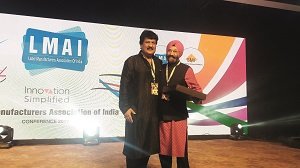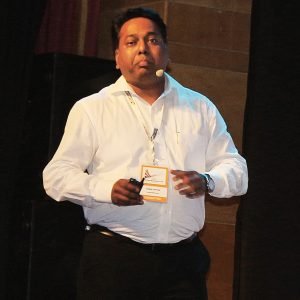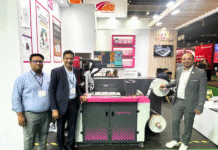The LMAI conference held biennially in alignment with Labelexpo Europe in Brussels took place in Agra from 20 to 23 July 2017. The conference has the strong support of Tarsus, the organizers of Labelexpo and the global label press and consumable manufacturers generally led by Avery Dennison and from the Indian manufacturers side by SMI Label products.

As Appadurai of HP said during his presentation, this is a well organized and lively event with a lot of singing and dancing, and this year it comes with a stiff dose of meditation and motivational management engagement. The mantra from morning to night was: recover from the previous night with meditation; try to stay awake for the knowledge presentations with coffee; and then celebrate again in the evening. This is not a bad way to run a networking event for the industry and it works at a variety of levels for the participants—many of whom were able to bring their families to the event and enjoy the evening music and dancing, visits to the Taj Mahal and the meditation and yoga sessions—quite unlike any other printing or packaging trade event practically anywhere in the world.
Simplifying innovation
Harveer Sahni of Weldon Celloplast and one of the founders of the Indian label printing movement was award a Lifetime Achievement Award by the LMAI at the beginning of the event. The first day’s presentation on the innovation theme of conference began with Jitesh Mehta of Avery Dennison speaking of new ideas and their implementation and how to reward the innovators for their good work. He also spoke about the upcoming demand for full color inkjet presses and his own company’s recent innovation in the uncoated white paper luxury-look label stock for wine bottles—Aqua Opaque. While most labelstock loses opacity and turns gray when wet, Avery’s new matt finish labelstock stays white even in wet condition such as immersing a wine bottle in an ice bucket for over two hours.
Bobst, Flint, Esko and Phoseon
Bobst marketing director Frederico D’annunzio spoke about his emotional connection with a market that he often speaks about with vehemence and he shared some of the ideas that are apparent in making an analog narrow web flexo press more digital. He spoke of the generational change in the workflow as the industry. There is much more coming from Bobst at Labelexpo Europe, not least from its recently launched joint venture with Radex called Mouvent that will show a pair of label presses in Brussels alongside the Bobst stand. In fact, Mouvent’s slogan with its two new digital inkjet printers LB701UV and LB 702UV could also be ‘simplifying innovation.’”
Kelly Kolliopoulos, the global marketing director of Flint Group, spoke about one of the coolest topics in the print world right now—LED UV curing, LED UV inks and the chemistry that Flint has provided to narrow web flexo printers since 2013. She spoke of the several benefits of UV LED curing technologies that are already prevalent in many industrial applications and how these enable new processes and capabilities across industries. Readers going to Labelexpo in Brussels should keep in mind that this year, for the first time, Flint and Xeikon which it acquired a couple of years ago will share the same stand at the show.
LED curing is currently the hottest topic in the industry and it was also addressed in the context of digital flexo imaging by Jan Buchweitz of Esko. Buchweitz described the benefits of LED UV curing in the post-processing of HD Flexo and Full HD flexo plates imaged on the new Esko CDI output devices. For instance, on the new Esko XPS Crystal 5080 digital flexo imaging device, the integration and automation of the digital imaging and LED UV exposure improves consistency and overall ease of use. Described as innovation through automation which drastically reduces manual steps, errors and operator time, this solution also reduces the footprint and maintenance of the equipment.
(The Phoseon presentation on the second day by Sunil Daddikar who is the technical director of its South Asian distributor UniUV & Light was also about LED curing. Phoseon is a company that is 100% focussed on LED UV curing and Daddikar provided some technical depth to the discussion of UV curing light sources. Phoseon’s LED lamps have been used without significant deterioration for long periods, lasting as long as 20,000 hours in contrast to conventional UV lamps that are generally rated at 1,000 hours.)
Omet, SMI, Insight and Screen
Going back to the first day’s presentations, Ajay Mehta of SMI Label Products thanked the industry for its continued support in making his company a global competitor in the labelstock industry. He then demonstrated SMI’s mobile app for choosing the right labelstock for any application, before addressing the overall advantages arising from the implementation of the goods and services tax (GST). With the withdrawal of sundry taxes such as octroi, he indicated that there would be a saving of 5.5% on labelstock that should lead to increased competitiveness. He also suggested that this is not an opportunity for profiteering and since Mehta’s voice is the voice of reason in the label industry, it should be heeded to rationally align the industry to profitable paths.
The Omet presentation began with Pawandeep Sahni of Weldon Celloplast speaking about consumer engagement and how label printers can upgrade their businesses. His colleague and Omet’s export manager Paolo Grasso spoke about the innovation process, in keeping with the conference theme that innovation needs and should be driven by simplification rather than complexity.
Ajay Aggarwal of Insight Print Communications spoke about technology evolution and primarily how UV inkjet has itself evolved and is steadily making inroads in the label production. Speaking more specifically about the Screen Truepress Jet L350UV press, he pointed out special features such as the choke function for sharp rendering of text as small as 4 points and the accuracy of its 4-level grayscale head for producing smoother gradations as well as precise bar and QR codes and fine dot codes for anti-counterfeiting labels.
Vinsak, AB Graphic and Mark Andy
Ranesh Bajaj of Vinsak expanded on the digital label production theme by recounting the progress of the label market over more than the past five years and pointing to some of the emerging technologies and trends such as the increased demand for digital labels and for in-mold labels in India. Keith Montgomery, business development manager of AB Graphic International, spoke of his company’s finishing solutions for both flexo and digital label presses and pointed out that many of the simpler models are now manufactured in India by Vinsak.

Effectiveness in the current climate of margin pressure
Shaun Pullen, Mark Andy’s sales director for Asia Pacific, began his presentation by discussing some of the pain points that label printers and converters typically face, namely wastage control, shrinking margins and difficulty in bringing operators up to the requisite skill levels needed for narrow web flexo presses. His subsequent slides suggested that the new label presses that are now available address these pain points with their shorter web path and fast changeover with load and lock systems.
The new presses such as Mark Andy’s Performance Series are able to handle a wide variety of substrates with their ease of operation aided by precise and quick web viewing, auto-registration, and improved throughput with less wastage which in turn can improve margins. Less waste of paper and ink and even press time implies less environmental impact. Pullen also mentioned Mark Andy’s simple and compact 4-color inkjet press, the Digital One which has already found an Indian customer—Barcom in Mumbai.
Gallus, Multitec and HP
On the second day, Samir Patkar of Gallus talked about the need for measuring and improving Overall Equipment Effectiveness (OEE) in the current climate of margin pressure. According to him, with an OEE of 45% flexo label printing is not catching up with industry benchmarks that are at OEE levels of 85%.

Modern label presses are equipped with many tools for process automation such as data transfer from prepress to press and from press to postpress equipment. In Patkar’s view, not only these possibilities but many of the other features in presses that have already been purchased and installed are not being utilized optimally. He attempted to motivate the audience by showing a video that contrasted the 58-second motor racing pit-stops of a bygone era with the current Formula 1 pit stops that take around 2 seconds. While many printers will find the analogy inappropriate, there are some who are sure to be inspired to figure out how to better use the technology they have and to try and set new OEE benchmarks.
Multitec’s Amit Ahuja had a very simple idea for simplifying innovation or improving throughput. It actually could also be classified as OEE improvement but rather than emphasizing technology, he made several suggestions that could be described as common sense best practices or innovations in working routines for label printing that would require investment in human capital and tools.
Ahuja advocated simpler and better housekeeping for label printing processes such as having a specialist team (like a pit stop crew) for job changeovers. He seemed to emphasize having the right person designated for the right job with enough tools and set-up equipment. With established processes, the split-second timing and coordination of a team trained to perform a particular task or process could improve the quality and speed of changeovers and subsequently the other parts of the label press operation.
Appadurai, who is responsible for HP’s Indigo and inkjet press sales in India, engaged and provoked the audience with his usual banter and sense of humor. Expertly urging creativity and innovation in marketing applications while picking apart the arguments against digital printing, he was basically urging label printers to take up the role of marketing service providers. He also showed some videos of imaginative examples of personalized and variable data packaging done with HP digital presses and software.
Research-based strategy for label exports
The presentation that was perhaps the most provocative and interesting at the LMAI conference came from a very knowledgable guest speaker—Sudhakar Kasture. Kasture is a researcher, author and trainer; he could also be described as an activist for Indian exports. He propounded an export strategy for labels by first showing how far behind the country is in exports as a whole and how great the opportunity might be if it was taken seriously.
The global pressure-sensitive label industry is on a path to grow from US$ 17 billion in 2016 to US$ 34 billion in 2024 according to Kasture. He pointed out that the new GST means that export benefits could henceforth only be applied to customs duties and that even Export Oriented Units will have to pay GST. His advocacy implies a strategic outlook based on research of global markets and of improvement in costs by reducing transaction costs. Exports efforts need to be far more efficient and migrate “from contact-based strategies to research-based strategies,” he said.












